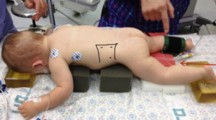Abstract
Aim
During retroperitoneoscopic renal surgery (RPRS), the open technique (OT) for trocar insertion is always associated with CO2 leakage around the first trocar, while the closed technique (CT) involves advancing an optical trocar into the retroperitoneal space (RS) under direct vision. We are the first to compare OT with CT.
Methods
Forty-one cases of RPRS performed for pyeloplasty (31), hemi-nephrectomy (4), nephrectomy (4), stone removal (1), and cyst excision (1) were studied. The initial 5 mm trocar was inserted using OT (n = 11) or CT (n = 30). The tip of a telescope was used for blunt dissection of the retroperitoneum to create the RS.
Results
Ages and weights at RPRS were similar (OT versus CT: 7.3 versus 7.1 years; 25.4 versus 25.0 kg; respectively). In CT, RS access was significantly faster (38.2 versus 5.6 min), RS was created significantly quicker (77.7 versus 31.9 min), and narcotic usage was significantly less (4.0 versus 1.5 days). In OT, CO2 leaked in 11/11 and the retroperitoneum was torn in 3/11. In CT there was no leakage and no tearing.
Conclusions
CT is quicker and safer than OT during RPRS.


Similar content being viewed by others
References
Diamond DA, Price HM, McDougall EM et al (1995) Retroperitoneal laparoscopic nephrectomy in children. J Urol 153:1966–1968
McDougall EM, Clayman RV, Fadden PT (1994) Retroperitoneoscopy: the Washington University Medical School experience. Urology 43:446–452
Keeley FX Jr, Tolley DA (1999) Retroperitoneal laparoscopy. BJU Int 84:212–215
Clayman RV, McDougall EM, Kerbl K et al (1993) Laparoscopic nephrectomy: transabdominal vs retroperitoneal. J Endourol 7:S139
Micali S, Caione P, Virgili G et al (2001) Retroperitoneal laparoscopic access in children using a direct vision technique. J Urol 165:1229–1232
Borer JG, Cisek LJ, Atala A et al (1999) Pediatric retroperitoneoscopic nephrectomy using 2 mm instrumentation. J Urol 162:1725–1729 (discussion 1730)
Borer JG, Peters CA (2000) Pediatric retroperitoneoscopic nephrectomy. J Endourol 14:413–416 (discussion 417)
McGrath PA, Seifert CE, Speechley KN et al (1996) A new analogue scale for assessing children’s pain: an initial validation study. Pain 64:435–443
Gill IS, Clayman RV, Albala DM et al (1998) Retroperitoneal and pelvic extraperitoneal laparoscopy: an international perspective. Urology 52:566–571
Capelouto CC, Kavoussi LR et al (1993) Complications of laparoscopic surgery. Urology 42:2
Jirecek S, Drager M, Leitich H et al (2002) Direct visual or blind insertion of the primary trocar. Surg Endosc 16:626–629
Sundbom M, Hedberg J, Wanhainen A et al (2013) Aortic injuries during laparoscopic gastric bypass for morbid obesity in Sweden 2009–2010: a nationwide survey. Surg Obes Relat Dis 27:220–227
Swank DJ, Bonjer HJ, Jeekel J (2002) Safe laparoscopic adhesiolysis with optical access trocar and ultrasonic dissection. A prospective study. Surg Endosc 16:1796–1801
Thomas MA, Rha KH, Ong AM et al (2003) Optical access trocar injuries in urological laparoscopic surgery. J Urol 170:61–63
Wolf JS Jr, Monk TG, McDougall EM et al (1995) The extraperitoneal approach and subcutaneous emphysema are associated with greater absorption of carbon dioxide during laparoscopic renal surgery. J Urol 154:959–963
Ng CS, Gill IS, Sung GT et al (1999) Retroperitoneoscopic surgery is not associated with increased carbon dioxide absorption. J Urol 162:1268–1272
Author information
Authors and Affiliations
Corresponding author
Additional information
This paper was presented at the 51st Annual Meeting of Japanese Society of Pediatric Surgeons, May 8–10, 2014 in Osaka, Japan.
Rights and permissions
About this article
Cite this article
Koga, H., Okawada, M., Doi, T. et al. Comparison between closed and open techniques for creating a retroperitoneal space for retroperitoneoscopic renal surgery in children. Pediatr Surg Int 30, 933–936 (2014). https://doi.org/10.1007/s00383-014-3566-y
Accepted:
Published:
Issue Date:
DOI: https://doi.org/10.1007/s00383-014-3566-y




